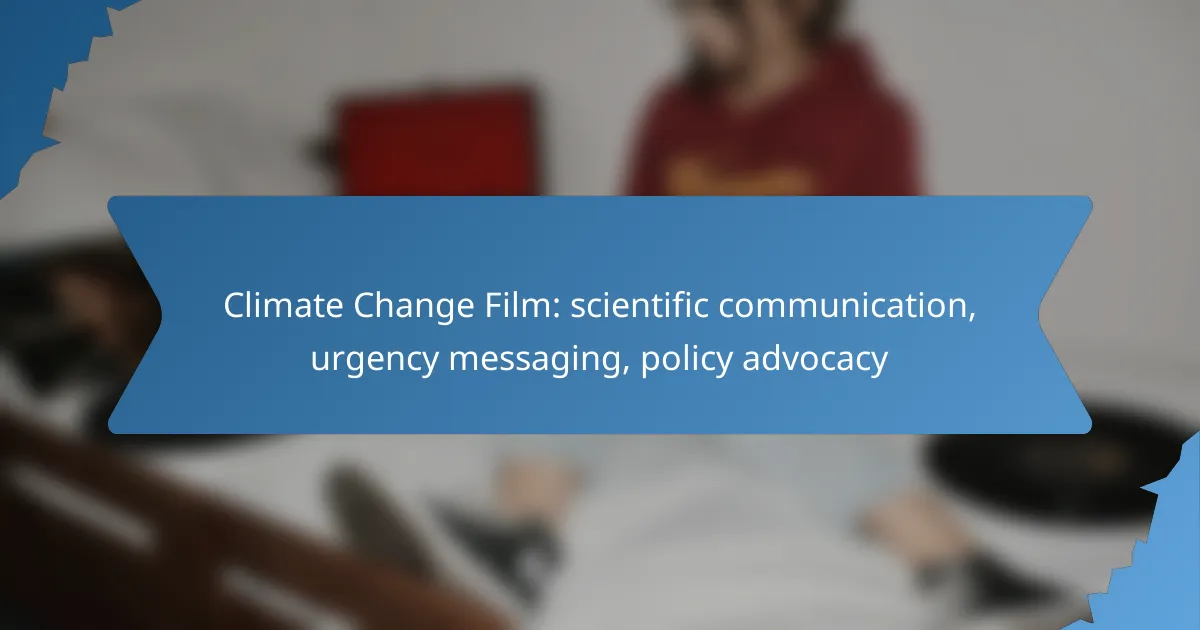Climate change films serve as vital instruments for scientific communication, transforming complex data into compelling narratives that resonate with diverse audiences. By highlighting urgent climate issues and their interconnectedness with human health and socioeconomic stability, these films motivate action and advocate for essential policy changes.
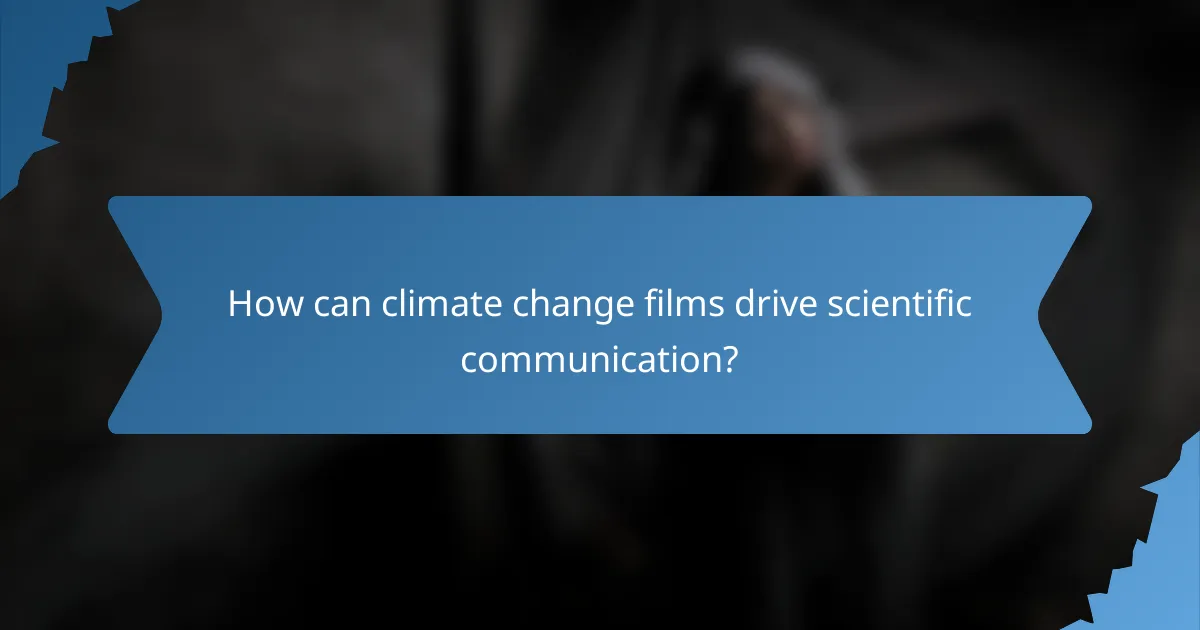
How can climate change films drive scientific communication?
Climate change films can effectively drive scientific communication by translating complex data into relatable narratives that resonate with audiences. They serve as powerful tools to raise awareness, motivate action, and influence policy by presenting urgent climate issues in an engaging format.
Engagement through storytelling
Storytelling in climate change films captivates viewers by personalizing the impacts of environmental issues. By focusing on individual experiences, filmmakers can evoke empathy and a sense of urgency, making the abstract concept of climate change more tangible.
For example, a film might follow a family affected by rising sea levels, illustrating their struggles and resilience. This narrative approach can inspire viewers to connect emotionally and consider their role in addressing climate challenges.
Visual data representation
Visual data representation in climate change films simplifies complex scientific information, making it accessible to a broader audience. Infographics, animations, and compelling visuals can highlight trends and projections, allowing viewers to grasp the severity of climate impacts quickly.
For instance, a film might use animated graphs to show the increase in global temperatures over the decades, effectively communicating the urgency of the situation. This method not only informs but also reinforces the emotional weight of the narrative.
Expert interviews and testimonials
Incorporating expert interviews and testimonials in climate change films adds credibility and depth to the narrative. Scientists, activists, and affected individuals can share their insights and experiences, providing authoritative perspectives on the urgency of climate action.
Including diverse voices, such as those from vulnerable communities, can highlight the disproportionate impacts of climate change and advocate for equitable solutions. This multifaceted approach strengthens the film’s message and encourages viewers to engage with the subject matter critically.
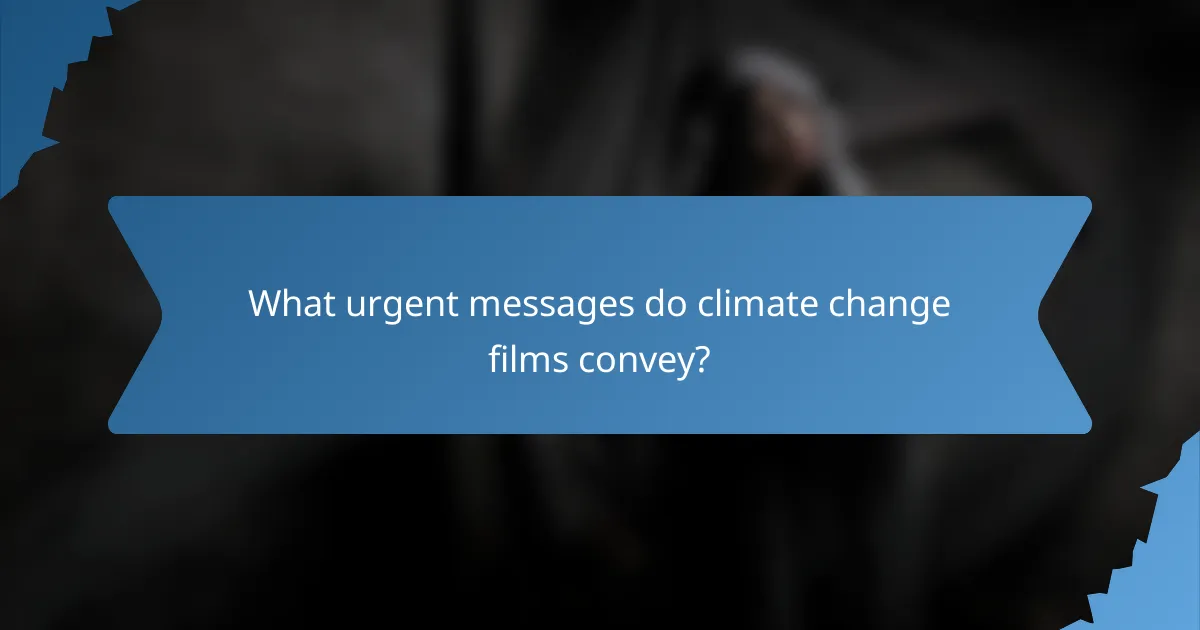
What urgent messages do climate change films convey?
Climate change films convey urgent messages about the immediate and long-term impacts of climate change on our planet, emphasizing the need for action. They highlight the interconnectedness of environmental issues, human health, and socioeconomic stability, urging viewers to recognize the critical state of our ecosystems and the necessity for policy advocacy.
Immediate threats to ecosystems
Climate change films often showcase the immediate threats to ecosystems, such as rising temperatures, habitat loss, and extreme weather events. These films illustrate how species extinction rates are accelerating, with many species facing survival challenges due to changing climates. For instance, coral reefs are experiencing bleaching events that threaten marine biodiversity.
Additionally, films highlight the impact of climate change on natural habitats, such as forests and wetlands, which are crucial for carbon storage and biodiversity. The loss of these ecosystems can lead to irreversible damage, making it vital for viewers to understand the urgency of protecting these environments.
Impact on human health
The impact of climate change on human health is a critical theme in climate change films. They often depict how rising temperatures contribute to increased heat-related illnesses and respiratory issues due to poor air quality. Vulnerable populations, such as the elderly and those with pre-existing health conditions, are particularly at risk.
Moreover, films address the spread of vector-borne diseases, like malaria and dengue fever, which are becoming more prevalent as climate conditions change. This highlights the need for public health initiatives that adapt to these emerging threats, emphasizing the importance of proactive measures to safeguard community health.
Socioeconomic consequences
Climate change films frequently explore the socioeconomic consequences of environmental degradation, illustrating how vulnerable communities face disproportionate impacts. These films often depict scenarios where agricultural productivity declines due to shifting weather patterns, leading to food insecurity and economic instability.
Additionally, they highlight the financial burden of climate-related disasters, such as hurricanes and floods, which can devastate local economies and displace populations. Viewers are urged to consider the importance of sustainable policies and practices that can mitigate these risks and promote resilience in affected communities.
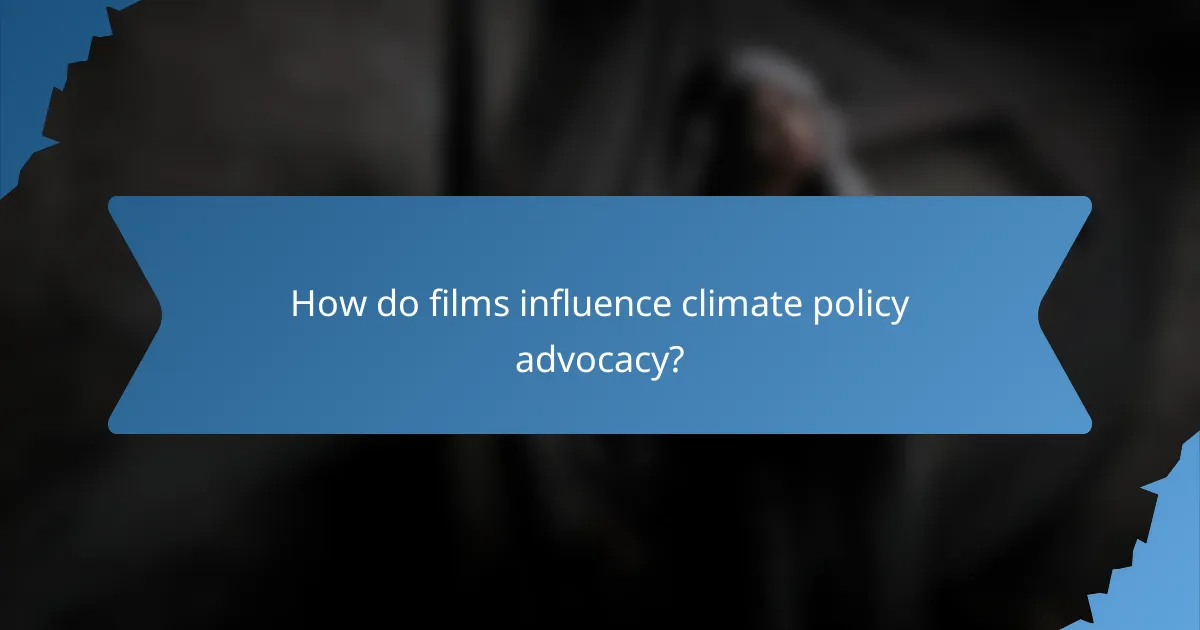
How do films influence climate policy advocacy?
Films play a significant role in shaping climate policy advocacy by effectively communicating scientific information and fostering emotional connections. They can drive public engagement and prompt policymakers to take action on climate issues.
Raising public awareness
Films raise public awareness about climate change by presenting complex scientific concepts in an accessible and engaging manner. Documentaries and narratives can highlight the urgency of the climate crisis, making it relatable to a broad audience.
For example, films like “An Inconvenient Truth” have sparked discussions around climate change, leading to increased public interest and concern. This heightened awareness can motivate individuals to seek more information and advocate for climate action.
Mobilizing grassroots movements
Films can galvanize grassroots movements by inspiring viewers to take collective action. By showcasing local activists and community initiatives, films encourage audiences to participate in environmental campaigns and initiatives.
For instance, films that document successful community-led projects can serve as blueprints for others, fostering a sense of empowerment and urgency. Social media campaigns often accompany these films, amplifying their reach and impact.
Influencing legislative change
Films can influence legislative change by shaping public opinion and creating pressure on policymakers. When films resonate with audiences, they can lead to increased demand for policy reforms and climate action from elected officials.
Documentaries that highlight the consequences of inaction can prompt viewers to contact their representatives, urging them to support climate-related legislation. This grassroots pressure can be pivotal in swaying legislative decisions and prioritizing climate policies in government agendas.
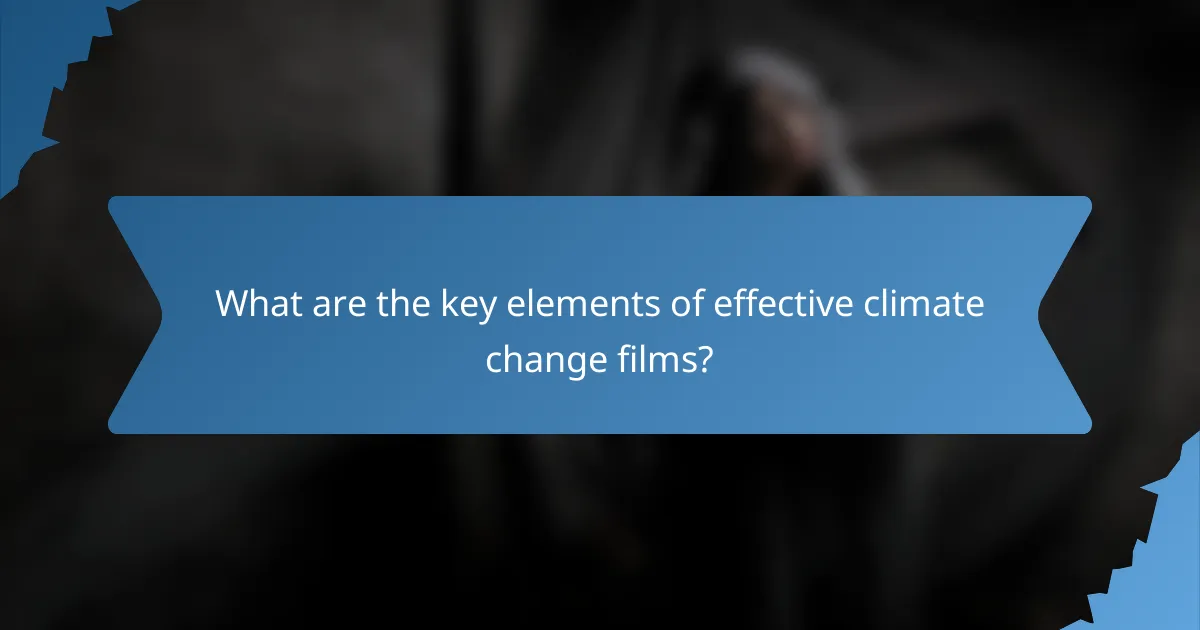
What are the key elements of effective climate change films?
Effective climate change films combine compelling narratives, scientific accuracy, and emotional resonance to engage audiences and drive action. These elements work together to communicate the urgency of climate issues and advocate for meaningful policy changes.
Compelling narratives
Compelling narratives are essential for capturing viewers’ attention and making complex climate issues relatable. A strong storyline often includes personal stories, real-life impacts, and clear characters that audiences can connect with emotionally. For instance, following a community affected by rising sea levels can illustrate the broader implications of climate change.
To create a compelling narrative, filmmakers should focus on a central theme and build a storyline that unfolds logically. This could involve showcasing the journey of individuals or groups fighting against climate change, highlighting their challenges and triumphs.
Scientific accuracy
Scientific accuracy is crucial in climate change films to ensure that the information presented is credible and trustworthy. Filmmakers should collaborate with climate scientists and experts to verify facts and data, avoiding exaggerations or misleading claims. This adherence to accuracy helps build trust with the audience and reinforces the film’s message.
Utilizing clear visuals, such as graphs or infographics, can effectively convey scientific concepts. For example, showing the increase in global temperatures over time can provide a stark visual representation of climate change trends.
Emotional resonance
Emotional resonance is vital for motivating viewers to care about climate change and take action. Films that evoke strong feelings—such as hope, fear, or urgency—can inspire audiences to engage with the issue on a personal level. Techniques like powerful imagery, music, and personal testimonials can enhance this emotional connection.
To maximize emotional impact, filmmakers should consider the tone of their message. While some films may focus on the dire consequences of inaction, others might highlight success stories of resilience and innovation, offering a balanced perspective that encourages viewers to act.

How do filmmakers choose topics for climate change films?
Filmmakers select topics for climate change films based on current scientific findings, societal impacts, and the urgency of the issues at hand. They often aim to raise awareness, inspire action, and influence policy by highlighting specific themes that resonate with audiences.
Current events and trends
Filmmakers closely monitor current events and emerging trends related to climate change, such as extreme weather events, policy changes, and scientific breakthroughs. These timely topics can engage viewers by connecting the film’s message to real-world situations, making the content more relatable and urgent.
For instance, a film might focus on the effects of recent wildfires or flooding in specific regions, illustrating the immediate consequences of climate change. By aligning their narratives with ongoing discussions in the media, filmmakers can amplify their impact and relevance.
Community impact stories
Community impact stories are powerful tools for filmmakers, as they showcase the human side of climate change. By featuring individuals or groups affected by environmental issues, filmmakers can create emotional connections that resonate with audiences and drive home the urgency of action.
For example, a documentary might highlight a small coastal town facing rising sea levels, detailing the struggles of residents and local businesses. These personal narratives can inspire empathy and motivate viewers to engage in climate advocacy or support policy changes that address these challenges.
